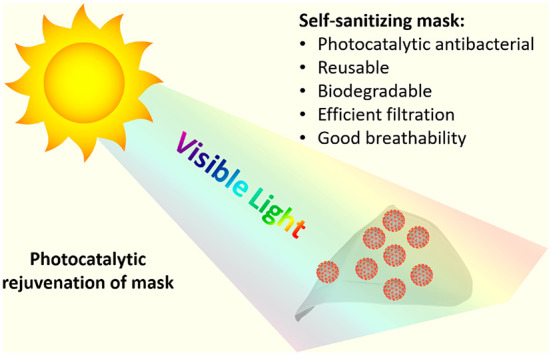- Record: found
- Abstract: found
- Article: not found
Photocatalytic Rejuvenation Enabled Self-Sanitizing, Reusable, and Biodegradable Masks against COVID-19

Abstract

Personal protective equipment (PPE) has been highly recommended by the U.S. Centers for Disease Control and Prevention for self-protection during the disastrous SARS-CoV-2 (COVID-19) pandemic. Nevertheless, massive utilization of PPE encounters significant challenges in recycling and sterilizing the used masks. To tackle the associated plastic pollution of used masks, in this work, we designed a reusable, biodegradable, and antibacterial mask. The mask was fabricated by the electrospinning of polyvinyl alcohol (PVA), poly(ethylene oxide) (PEO), and cellulose nanofiber (CNF), followed by esterification and the deposition of a nitrogen-doped TiO 2 (N-TiO 2) and TiO 2 mixture. The fabricated mask containing photocatalytic N-TiO 2/TiO 2 reached 100% bacteria disinfection under either 0.1 sun simulation (200–2500 nm, 106 W m –2) or natural sunlight for only 10 min. Thus, the used mask can be rejuvenated through light irradiation and reused, which represents one of the handiest technologies for handling used masks. Furthermore, intermolecular interactions between PVA, PEO, and CNF enhanced the electrospinnability and mechanical performance of the resultant mask, which possesses a 10-fold elastic modulus and 2-fold tensile strength higher than a commercial single-use mask. The porous structures of electrospun nanofibers along with strong electrostatic attraction enabled breathability (83.4 L min –1 of air flow rate) and superior particle filterability (98.7%). The prepared mask also had excellent cycling performance, wearability, and stable filtration efficiency even after 120 min wearing. Therefore, this mask could be a great alternative to current masks to address the urgent need for a sustainable, reusable, environmentally friendly, and efficient PPE under the ongoing COVID-19 contagion.
Related collections
Most cited references31
- Record: found
- Abstract: found
- Article: not found
Respiratory virus shedding in exhaled breath and efficacy of face masks
- Record: found
- Abstract: found
- Article: not found
Cellulose nanofibers prepared by TEMPO-mediated oxidation of native cellulose.
- Record: found
- Abstract: found
- Article: not found